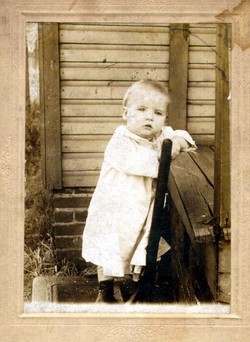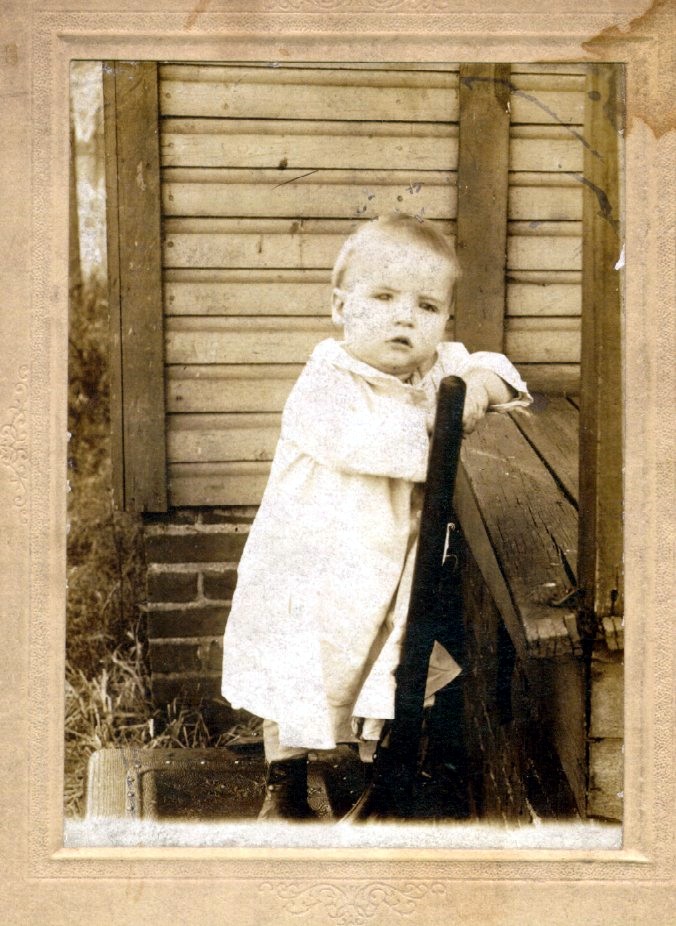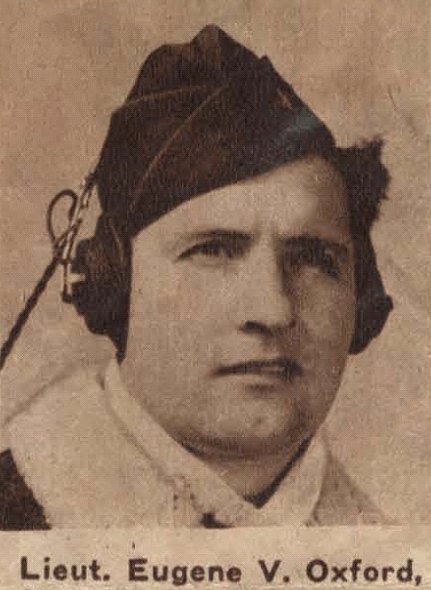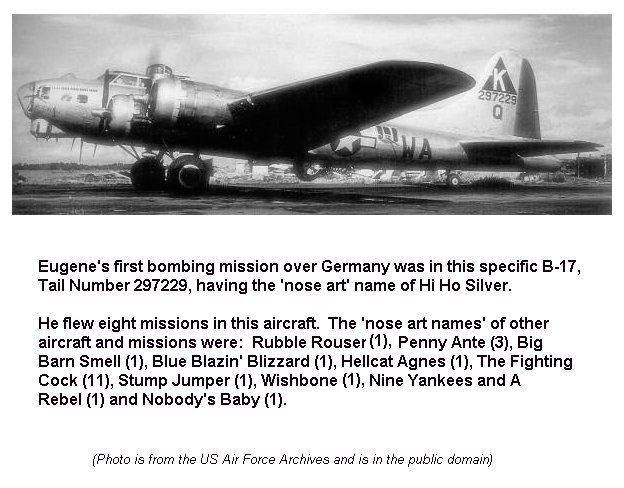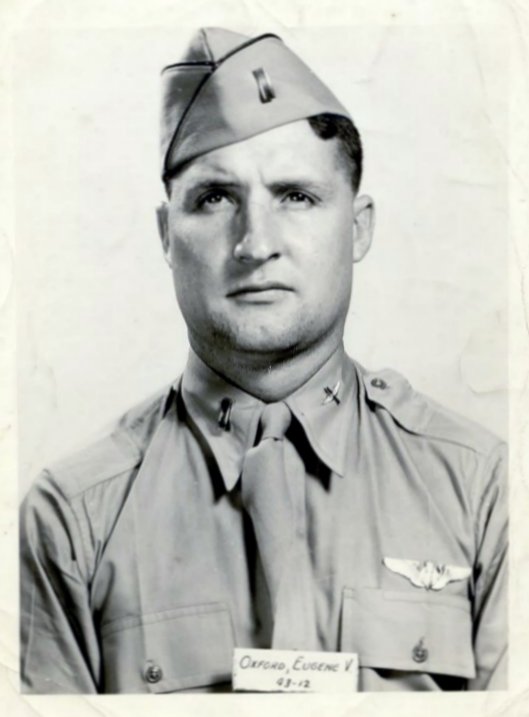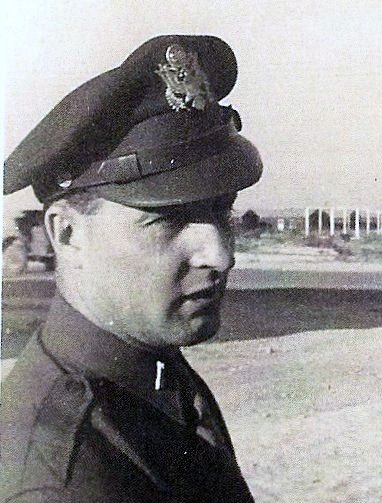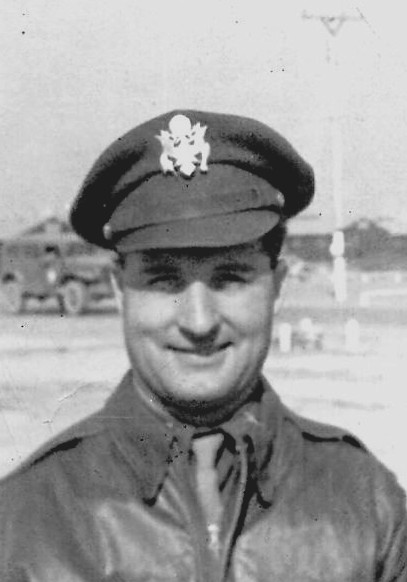On 13 Feb 1941, Gene enlisted in the U.S. Army Air Corps (it became the Army Air Force in June 1941) and was trained as an airplane mechanic. After the start of WW II, he was accepted for pilot training but was unable to complete the program. He was then accepted for, and graduated from, bombardier training. He received his wings and was commissioned a Second Lieutenant on 17 Apr 1943. He was assigned to a B-17 crew with whom he trained at Pyote Army Air Base, Texas. After training, the aircrew flew a new B-17G from Nebraska to England, arriving there on 11 Mar 1944. They were assigned to the 524th Bomb Squadron, 379th Bomb Group (H), at Kimbolton, England. Gene's first mission was a ball bearing plant at Schwienfurt, Germany, on 13 Apr 1944. His thirtieth and final mission was an oil refinery on 20 Jun 1944, and all missions but one were flown with the same basic aircrew. Having completed his required number of missions, he departed for the U.S. on 16 Jul 1944. He was in redeployment training for the Pacific Theater when the war ended, and he was discharged on 15 Sep 1945. His awards and decorations include the Distinguished Flying Cross, Air Medal w/three oak leaf clusters and the European Service Medal.
After returning home, Gene became friendly with a young Navy veteran, John Hoover. He subsequently married John's mother, Edith V. Higginbotham Hoover. They never had children of their own but, later in life, Gene took pride in being the grandfather of John's two boys.
~~~~~~~~~~~~~~~~~~~~~~~~~~~~~~~~~~~~~~~~~~~~~~~~~~~~~~~
END NOTE: The original B-17 aircrew consisted of four officers and six enlisted men. During ETO operations and to compensate for lack of trained personnel (due to high aircraft and crew losses), one of the waist gunner positions was eliminated after the 1 May 1944 mission. Command again changed the crew make-up after the 27 May 1944 mission, by removing the Navigator except in lead aircraft. The latter position loss was filled by an enlisted Nose Gunner/Togglier (the earlier departed waist gunner returned to the crew). In addition to Gene, the other aircrew members were Pilot Carlton A. Wilkins, Co-Pilot James A. Sinclair, Navigator Carson J. Minard, Radio Operator/Gunner Donald W. Krenrick, Engineer/Top Turret Gunner Kyle A. Field, Waist Gunner John W. Waters, Waist Gunner/Nose Gunner/Togglier Lewis L. Leblond, Ball Turret Gunner John J. MacDonald (1922-1991) and Tail Gunner Walter E. Collins (who was killed in action).
To provide some understanding of the threat my brother and his aircrew faced on THEIR specific bombing missions alone, the 8th AF records reflect that 156 B-17s were lost and 1,202 men were MIA (some MIAs would become POWs, but many would later be listed as KIA). One mission alone (Berlin, 24 May 1944) resulted in the loss of 33 B-17s, 4 KIA, 24 WIA and 482 MIA.
FINIS: Beginning in 2007, I initiated a search for the crew members with whom my brother served. I was elated to find that three were still living. I had talked with Mr. Sinclair and Mr. Waters periodically before their deaths, and our conversations were always a pure joy for me. I also feel good about the fact that I re-introduced them to each other after these many years. Regretfully, the last of those three, Mr. Krenrick, with whom I never got to speak, has now passed on. Our "Greatest Generation" is quickly coming to a close.
On 13 Feb 1941, Gene enlisted in the U.S. Army Air Corps (it became the Army Air Force in June 1941) and was trained as an airplane mechanic. After the start of WW II, he was accepted for pilot training but was unable to complete the program. He was then accepted for, and graduated from, bombardier training. He received his wings and was commissioned a Second Lieutenant on 17 Apr 1943. He was assigned to a B-17 crew with whom he trained at Pyote Army Air Base, Texas. After training, the aircrew flew a new B-17G from Nebraska to England, arriving there on 11 Mar 1944. They were assigned to the 524th Bomb Squadron, 379th Bomb Group (H), at Kimbolton, England. Gene's first mission was a ball bearing plant at Schwienfurt, Germany, on 13 Apr 1944. His thirtieth and final mission was an oil refinery on 20 Jun 1944, and all missions but one were flown with the same basic aircrew. Having completed his required number of missions, he departed for the U.S. on 16 Jul 1944. He was in redeployment training for the Pacific Theater when the war ended, and he was discharged on 15 Sep 1945. His awards and decorations include the Distinguished Flying Cross, Air Medal w/three oak leaf clusters and the European Service Medal.
After returning home, Gene became friendly with a young Navy veteran, John Hoover. He subsequently married John's mother, Edith V. Higginbotham Hoover. They never had children of their own but, later in life, Gene took pride in being the grandfather of John's two boys.
~~~~~~~~~~~~~~~~~~~~~~~~~~~~~~~~~~~~~~~~~~~~~~~~~~~~~~~
END NOTE: The original B-17 aircrew consisted of four officers and six enlisted men. During ETO operations and to compensate for lack of trained personnel (due to high aircraft and crew losses), one of the waist gunner positions was eliminated after the 1 May 1944 mission. Command again changed the crew make-up after the 27 May 1944 mission, by removing the Navigator except in lead aircraft. The latter position loss was filled by an enlisted Nose Gunner/Togglier (the earlier departed waist gunner returned to the crew). In addition to Gene, the other aircrew members were Pilot Carlton A. Wilkins, Co-Pilot James A. Sinclair, Navigator Carson J. Minard, Radio Operator/Gunner Donald W. Krenrick, Engineer/Top Turret Gunner Kyle A. Field, Waist Gunner John W. Waters, Waist Gunner/Nose Gunner/Togglier Lewis L. Leblond, Ball Turret Gunner John J. MacDonald (1922-1991) and Tail Gunner Walter E. Collins (who was killed in action).
To provide some understanding of the threat my brother and his aircrew faced on THEIR specific bombing missions alone, the 8th AF records reflect that 156 B-17s were lost and 1,202 men were MIA (some MIAs would become POWs, but many would later be listed as KIA). One mission alone (Berlin, 24 May 1944) resulted in the loss of 33 B-17s, 4 KIA, 24 WIA and 482 MIA.
FINIS: Beginning in 2007, I initiated a search for the crew members with whom my brother served. I was elated to find that three were still living. I had talked with Mr. Sinclair and Mr. Waters periodically before their deaths, and our conversations were always a pure joy for me. I also feel good about the fact that I re-introduced them to each other after these many years. Regretfully, the last of those three, Mr. Krenrick, with whom I never got to speak, has now passed on. Our "Greatest Generation" is quickly coming to a close.
Gravesite Details
The marker erroneously reflects a rank of Aviation Cadet because the wrong military discharge transcript was used. This error was not unusual for those airmen who did not complete pilot training.
